![]() Download the PDF (588KB)
Download the PDF (588KB)
The world’s first writing —cuneiform —(fig. 1) traces its beginnings back to an ancient system of accounting. This method of accounting used small geometrically shaped clay tokens to keep track of goods such as livestock and grain produced in the early farming communities of the ancient Near East. Writing, however, did not spring full blown from clay tokens. Surprisingly, it took the Mesopotamian belief in an afterlife to transform a dry and dusty accounting system into what we recognize as writing.
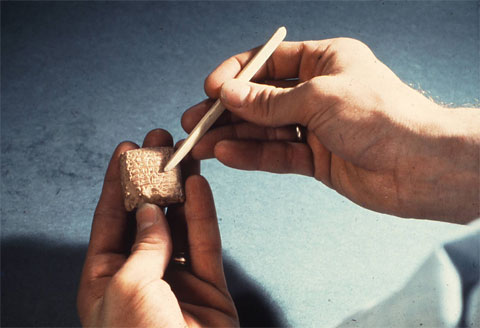
The Mesopotamians believed that to secure eternal life their names had to be kept alive by being spoken after their death. To insure the eternal vitality of their names and their ghosts, the Mesopotamians repurposed the old accounting symbols into phonetic signs “spelling” out a person’s name. Individuals’ names were inscribed on funerary offerings and served, in effect, as perpetual utterances of a name. Over time, the phonetic name inscriptions evolved into phonetic sentences appealing to the gods for eternal life. These impassioned supplications were the final stage of transition from the clay tokens of old into the first writing.
Before Writing: Accounting with Tokens
—CA. 7500–3350 BC
Early farmers of the Near East invented a system of small tokens to count and account for the goods they produced. (fig. 2) The token shapes represented various kinds of merchandise prevalent in the farming economy of the time. For example, a cone stood for a small measure of barley, a sphere for a larger measure of barley and a disc for sheep. The number of units of goods was expressed by the number of tokens in a one–to–one correspondence: three small measures of barley were shown by three cones.

With the advent of cities about, ca 3500 BC, the repertory of tokens increased to some 300 shapes to represent the multiplicity of goods manufactured in urban workshops. Some of the new tokens were miniature representations of the units of goods they stood for. (fig. 3) Others bore multiple markings. There were, for example, a series of discs bearing on their face different patterns of incised lines or dots, which stood for a variety of textiles and garments. (fig. 4)

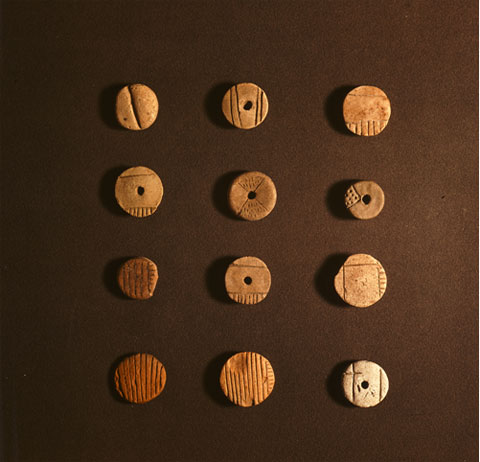
In the Near East, therefore, the first abstract communication system consisted of counters for counting and accounting. There can be no doubt that the simple clay tokens served well the Neolithic and Early Bronze communities since they were used consistently for 5000 years from Syria to Afghanistan and from Anatolia to Palestine.
The Birth of Writing: The First Impressed Texts
—CA. 3350 —3100 BC
The early city states still used tokens to control the levy of dues. When individuals could not pay, the tokens representing the amount of their debts were kept in a round clay envelope. In order to be able to verify the content of the envelope without breaking it, the tokens were impressed on the surface before enclosing them. A cone left a wedge–shaped mark and a disc a circular one. (fig. 5)
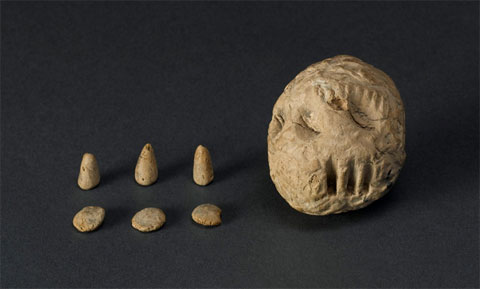
Reducing the three–dimensional tokens to two–dimensional signs proved revolutionary: It was the invention of writing. The tokens enclosed in hollow envelopes were replaced by their markings impressed on clay tablets. (fig. 6) After 5000 years, the old accounting system that used clay tokens came to an end and writing started its own long journey. However, both the last tokens enclosed in envelopes and the first signs impressed on tablets kept the same function – accounting. The impressed notations continued to record the same quantities of the same goods, mostly barley and animals, for the same granaries and sheepfolds of the Mesopotamian temple.
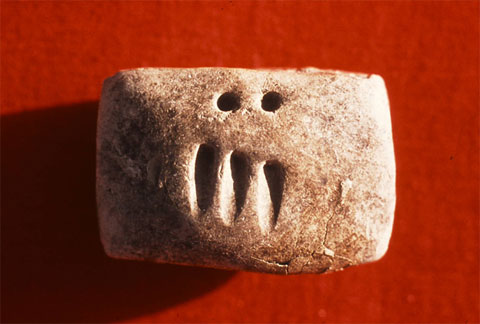
Incised Logographic Tablets
—CA. 3100–3000 BC
The markings representing the most frequently transacted goods, such as barley, continued to be impressed when a second way of writing was developed to picture the more complex tokens and their markings. The new technique consisted of tracing signs with a pointed reed stylus. The resulting signs are referred to as “incised” signs. (fig. 7)
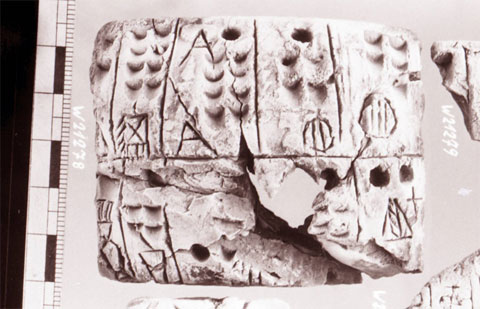
About 3000 BC, a small number of tablets listed together incised signs related to a particular topic such as trees, professions or cities to be used as reference, or as teaching tool by the accountants. These lexical texts show that the script soon expanded to include logograms (1 sign = 1 item) that no longer derived from tokens. Although the sign lists were only indirectly related to accounting, they still preserved the format typical of the economic tablets (2 sheep, 3 goats…) by listing each logogram preceded by the digit “1” (1 sheep, 1 goat…)
Phonetic Signs
—CA. 3000 BC
Around 3000 BC, as a mere bureaucratic formality, personal names began to be entered on economic tablets. The administration of Uruk, the Mesopotamian metropolis, was seemingly no longer satisfied with mere lists of the goods received or disbursed by the temple but started to include information about who gave or who received the listed goods. The Uruk scribes in their wisdom did not create new logograms to transcribe individuals’ names. Instead, they initiated new signs: phonograms – signs standing for sounds. Phonograms consisted of small pictures, easy to draw, evoking words that sounded like a given name. A typical Mesopotamian name such as “An is my life” could be written by combining a star, the logogram for An, the god of heaven, followed by the picture of an arrow, because the words for “arrow,” and “life,” were homonyms in Sumerian. The verb was not transcribed. This did not cause any difficulty, because this type of name was common in Sumer and it was easy for people to complete. When a name required several syllables, the corresponding phonograms were assembled like a rebus. For instance, the name Lucas could have been written with two phonograms: the sketch of a man and that of a mouth, which sounded “lu” and “ka” in the Sumerian language.
The registration of individuals’ names is unanimously recognized as an event of utmost importance in the development of the cuneiform script because conferring a sound value to a sign constituted the first link between writing and spoken language. After transforming the cumbersome tokens into a flexible script and creating incised logograms, the Mesopotamian accountants can be credited with phonetisation.

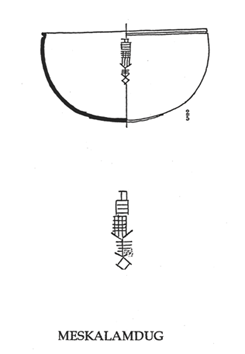
Beyond Accounting: The Funerary Function
—CA. 2700–2500 BC
After five centuries of total commitment to accounting, writing surprisingly changed course in the Mesopotamian city of Ur. This took the form of texts featuring personal names inscribed on splendid metal vases and stone cylinder seals. The dozen artifacts, ranking among the art masterpieces of all times, were excavated in some of the wealthiest burials excavated in the Royal Cemetery. Among them, three gold vessels bearing the name “Meskalamdug,” (fig. 8a and b) were part of the private grave of a male outfitted with an extraordinary amount of sumptuous funerary gifts, such as metal vessels, weapons and tools; a profusion of lapis lazuli and gold beads as well as heaps of gold headdress, bracelets, beads and earrings. The three inscribed vessels were found in close proximity of the skeleton and touchingly, one bowl (Fig. 9) was between the skeleton’s hands.
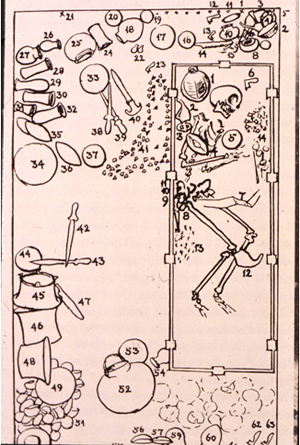
One of the inscribed cylinder seals was recovered in a female tomb found intact, which was filled with splendid funerary gifts, among which fluted gold tumblers and a mass of jewelry in the form of wreaths, (fig. 10) gold ribbons, earrings, pins, amulets and strings of beads of silver, gold, lapis lazuli, carnelian, agate and chalcedony. The seal bore an elaborate carved composition representing a (funerary?) banquet where males and females, clad in the typical fringed Sumerian garment, are shown raising their cups while faithful servants are busy attending them. (fig.11) The inscription “Puabi, Queen,” is held to disclose the name and title of the tomb’s female occupant. (fig. 11)
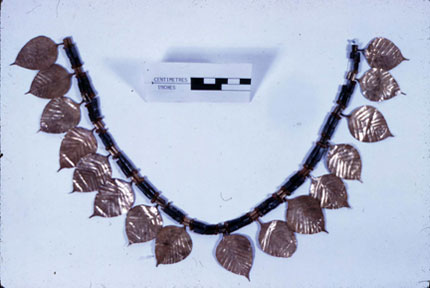
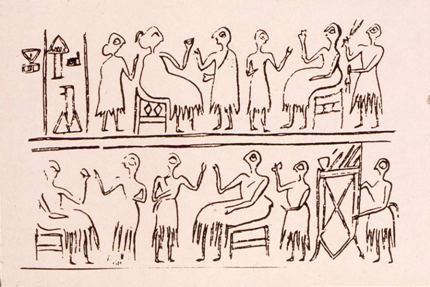
The Ur inscriptions differed from the previous economic texts in form and content. Of course their most obvious distinction was that they were written on works of art rather than on mundane tablets. The economic and lexical texts were written on clay, the cheapest possible material. By comparison, the Ur texts were engraved on gold and lapis lazuli, the most prized metal and stone in Sumer. Making a tablet took only molding a lump of clay into a plain cushion shape. The Ur metal vessels, however, were designed in elegant forms and the seals bore some of the most intricate compositions of the entire Mesopotamian glyptic repertory. They were wrought by talented craftsmen in the difficult crafts of metalwork and seal carving. To couch their names in writing, Meskalamdug and Puabi exchanged the dull color of clay with respectively, the warm gleam of gold and the deep blue color of lapis lazuli. However, the most significant change was the substitution of clay for stone and metal. The fragile tablets were replaced with hard and durable objects, which did not corrode nor tarnish, meant to last forever.
There was yet another major linguistic difference of utmost importance between the Uruk tablets and the Ur texts. Whereas the economic texts used logograms (one sign = 1 item) to refer to goods, and the lexical texts listed all the logograms pertaining to a topic, the names of Meskalamdug, or Puabi, consisted of syllabograms (one sign = one syllable). The terse Ur inscriptions constituted the first entirely phonetic texts. Writing was modeling itself on the sound of speech.
Finally, the Ur inscriptions differed in content. The texts were not dealing with quantities of goods nor did they catalog signs. They consisted of a single personal name, such as “Meskalamdug”(fig. 8b), or a name and a title, such as “Puabi, Queen.” (fig. 11) Therefore, unlike the thousands of economic tablets that listed numbers of units of goods, and unlike the hundreds of lexical texts, where each entry was preceded by the digit one the Ur texts featured no numerals. The inscribed art works of Ur stand out as the first texts having no direct or indirect ties to accounting. At Ur, writing finally broke away from a 5000 year old tradition of administrative records. It took a momentous turn to serve the dead.
The fact that names were inscribed on burial furniture of the Royal Cemetery, and that the objects were found in tombs – in one instance even between a skeleton’s hands – leaves little doubt that the new function of writing was funerary. Furthermore, because all the Ur texts featured a name, and several consisted merely of one name, it appears that inscribing the name of a deceased individual was the main purpose of the funerary inscriptions. The selection of precious materials further implies that the intent of the inscribed objects was to iconize the names of the deceased, associating them with the brilliance of metal and the benefic color of semi–precious stones. Finally, the choice of hard and impervious materials suggests that the names of the Ur individuals were meant to last forever.
The Name in Mesopotamia
Significantly, Mesopotamia had a particular understanding of names. These people believed that things came into existence by giving them a name. Conversely something without a name could not exist. For instance, they described the world before the creation in these words “… when above, the heavens were not named, below, the earth was not given a name” and “… when none of the gods had been created, not called by name.”
The Mesopotamians further held that personal names were the essence of an individual. Like a horoscope, a name controlled the fate of a person; like a genetic code, it programmed people to play a given role in the divine plans inscribed on the tablets of destiny. The kings of Sumer, therefore, boasted about the “fine name” bestowed upon them by a goddess such as Inanna, the goddess of love. As it is illustrated in mythological texts from Sumer to Babylon, changes of status prompted receiving additional names. For example, after Inanna gave birth, she also became known as Ishara. Extraordinary personalities warranted several names to fulfill their remarkable destiny. Marduk, the mightiest god of the Babylonian pantheon, had no less than fifty names to express, or rather, define his greatness.
Because names were considered to control a person’s fate, it is natural that they played an important role in the Mesopotamian conception of death and in the cult of the dead. For instance, the belief was that, immediately after drawing their last breath, Gestinanna, the scribe of the netherworld, checked the names of the departed against the list of those who were to die on that day. If they matched, the ghosts were set on the road to the netherworld.
More importantly, in order to achieve peace in the afterlife, the deceased, after proper funerary rituals and offerings of food and beverage, required the invocation of their names at regular intervals. The ritual of invoking the name of ancestors (Akkadian: shuma zakaru) was executed by an appointed kin (zakir shumi) –”the one who invokes by name.” It, generally, took place on the darkest night of the month, when there was no moon. Should the name fail to be uttered, the ghost would wander the earth and haunt the living. The ultimate threat was that one’s name might be erased from the tablets of destiny, signifying instant and total annihilation. Therefore it is understandable that the fear of having no one to utter their names was of great concern to all. The Sumerian King Shulgi expressed it well in his prayer: “… That my name be established for distant days, that it never falls into oblivion.” Other texts echo the same theme:
“… Any soldier who fell while on his lord’s service,
Princes, Princesses,
All humanity, from the East to the West,
Who have no one to care for them or call their names,
Come, eat this, drink this,
And bless Ammi–Shaduqa, son of Ammiditana, King of Babylon.”
Could the Ur texts featuring names find an explanation in the Mesopotamian fear of oblivion? Could it be that Meskalamdug, and the other Ur nobles buried with extravagant wealth, had their names inscribed to thwart their disappearance from the tablets of life? Did they reason that, because the phonetic signs captured the sounds of their name, writing had the awesome power of a perpetual utterance? If so, the intent of the Ur texts was to supplement or replace the all too fallible zakir shumis. This quest for obtaining immortality succeeded in advancing writing beyond accounting.
Votives Statues
2500–2300 BC
The funerary texts from Ur inscribed with personal names opened a new avenue for writing. They were followed by a variety of votive objects which further advanced its evolution. Among these artifacts, small alabaster inscribed statues, 10–30 cm high, were recovered in the ruins of temples in Near Eastern sites such as Nippur or Mari. Many of these are the figures of a standing male worshipper with his hands joined or holding a libation cup. (fig. 12) The figures wear the typical kaunakes, or sheep skin kilt with superimposed layers of tufts of wool. Some of them are engraved with an inscription, either in front of the bare torso, or more often on the right shoulder. Like at Ur, the texts consisted of a personal name alone or followed by a title. But, little by little, the texts on the statues were lengthened. For example, some stated the name of the god, or the temple, to whom the piece was dedicated. Finally, statues of individuals, like a certain Nani, bore a complete sentence. The inscription read: “Nani, his statue to Ninni–Zaza dedicated.” The message thus included Nani’s name, as subject or nominative, “statue” as complement or accusative, the god’s name, “Ninni–Zaza,” as dative, and “dedicated” was the verb. The inscription on the statue of Nani formulated a full sentence emulating the syntax of speech.
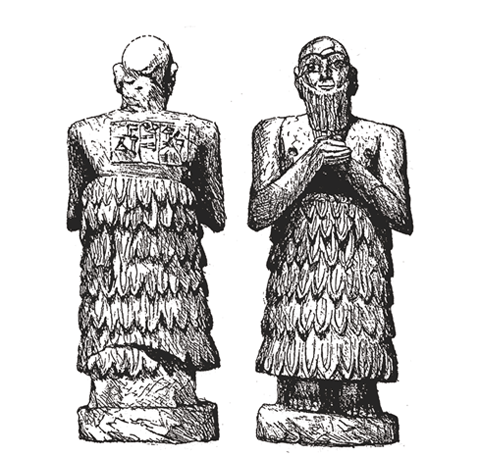
Drawn by Lewis R. (Bill) Wiman.
Courtesy Denise Schmandt–Besserat.
The few words “for the life of X” often recurring at the end of such texts make clear that the votive statues were offered to the gods to obtain someone’s eternal life. Like Meskalamdug, Nani may have believed that inscribing his name on a stone figure could replace a spoken invocation. But the figures were meant to do far more than Meskalamdug’s precious bowl. Nani’s statue, placed in front of a deity, was expected to pray perpetually for someone’s blessed afterlife. And to be sure that the plea be heard and understood by the gods, the little figure was given a full message in common speech. This was the ultimate emancipation of writing from accounting.
Conclusion: Classical Cuneiform Script
CA. 2000 BC.
Tokens were entirely devoted to accounting for 5000 years. The same was true for the impressed and incised tablets for another 500 years. It took the specter of death and nothingness to shift writing from economic lists and write names on funerary furniture. It was the desire to speak to the gods that pushed writing to reproduce speech. From there on, it took less than five centuries for the Mesopotamian cuneiform script to reach its classical period, ca. 2000BC. The Ur texts and the statues inscriptions were the gateway to the lengthy historical, religious, legal, literary, medical, magical texts that followed after 2500 BC.
For Further Reading
Diane Katz, “Death they Dispensed to Mankind —The Funerary World of Ancient Mesopotamia,” Historiae vol. 2, 2005, p. 55–90.
Jack N. Lawson, The Concept of Fate in Ancient Mesopotamia of the First Millennium, Towards an understanding of Shimtu, Harrassowitz Verlag, Wiesbaden, 1994.
Mario Liverani, The Ancient Near East, History, Society and Economy, Routledge, London 2014.
Denise Schmandt–Besserat, When Writing Came About, The University of Texas Press, Austin 1996.
Denise Schmandt–Besserat, When Writing Met Art, The University of Texas Press, Austin 2007.
Jo Ann Scurlock, “Death and Afterlife in Ancient Mesopotamian Thought,” in Jack Sasson, ed., Civilizations of the Ancient Near East, Vol. III, Scribners, New York 1995, p. 1883–1893.
Richard L. Zettler and Lee Horne, Eds., Treasures from the Royal Tombs of Ur, University of Pennsylvania Museum of Archaeology and Anthropology, Philadelphia 2000.
Page last updated: 4/25/2015